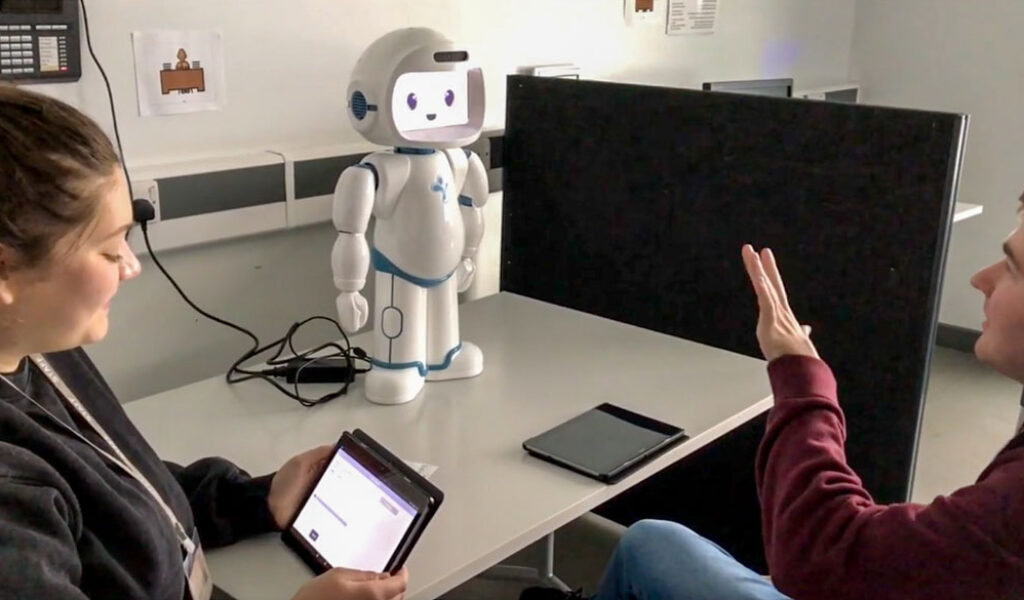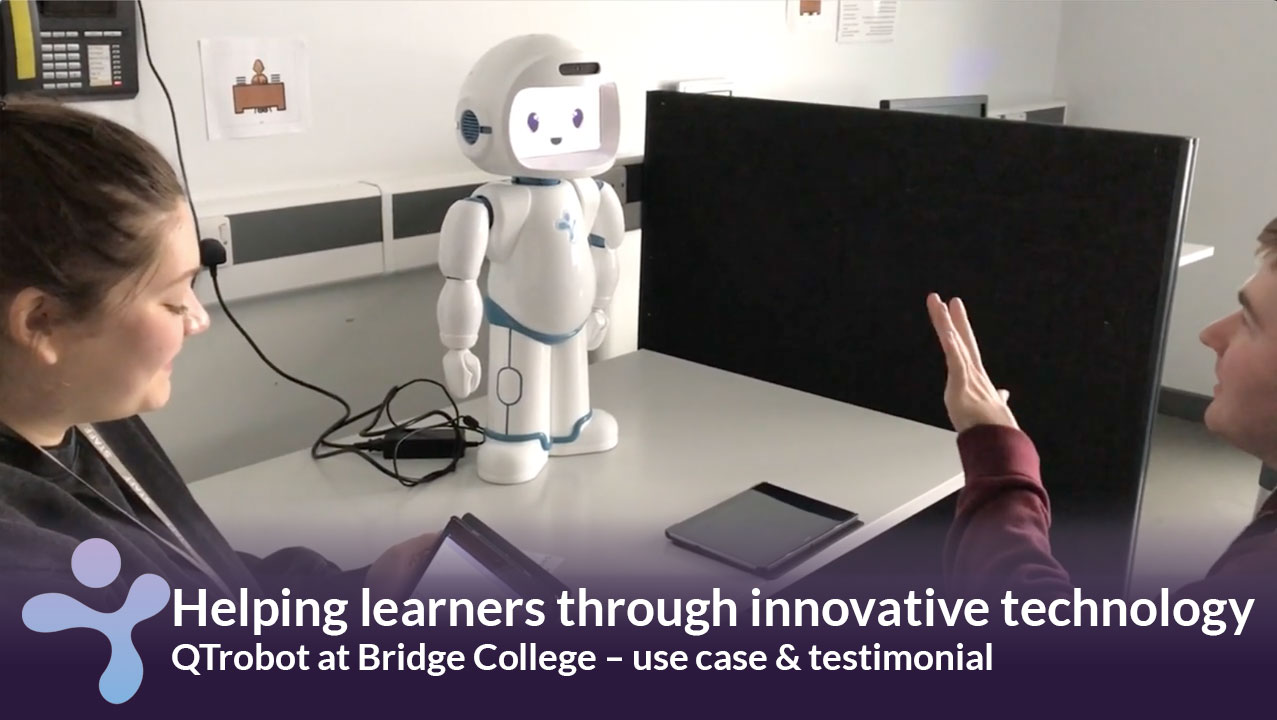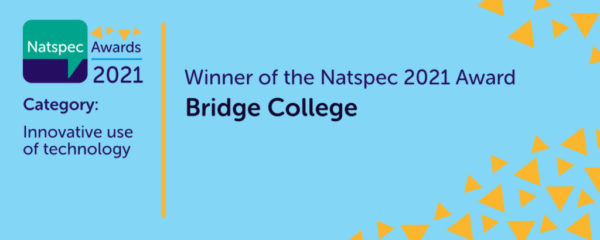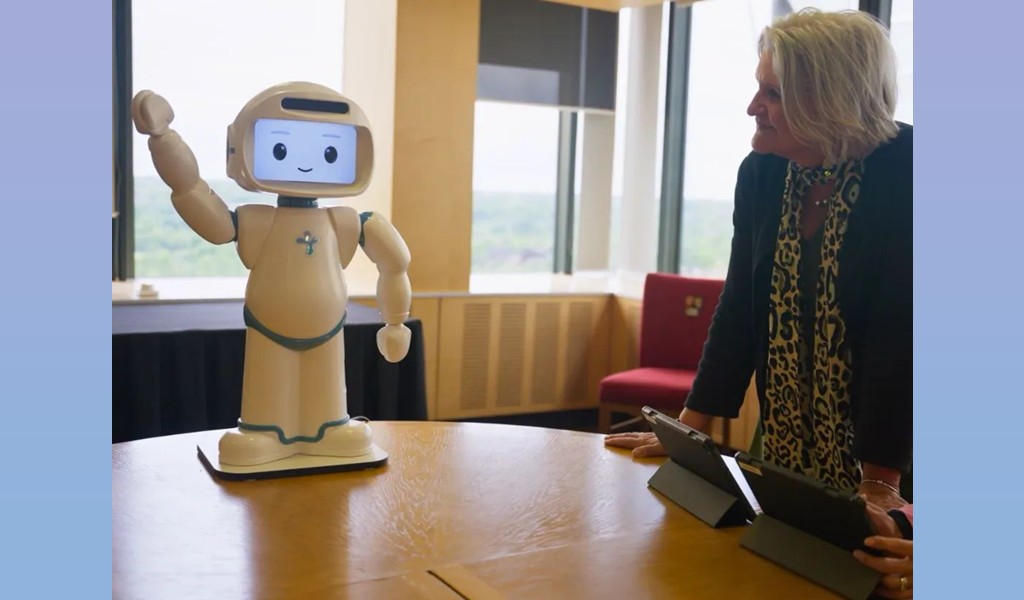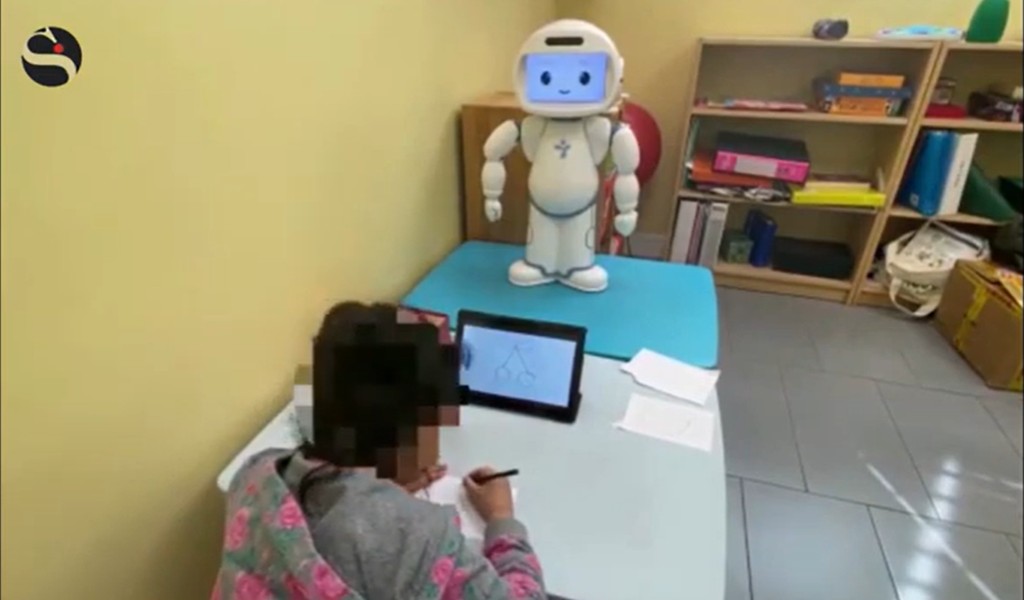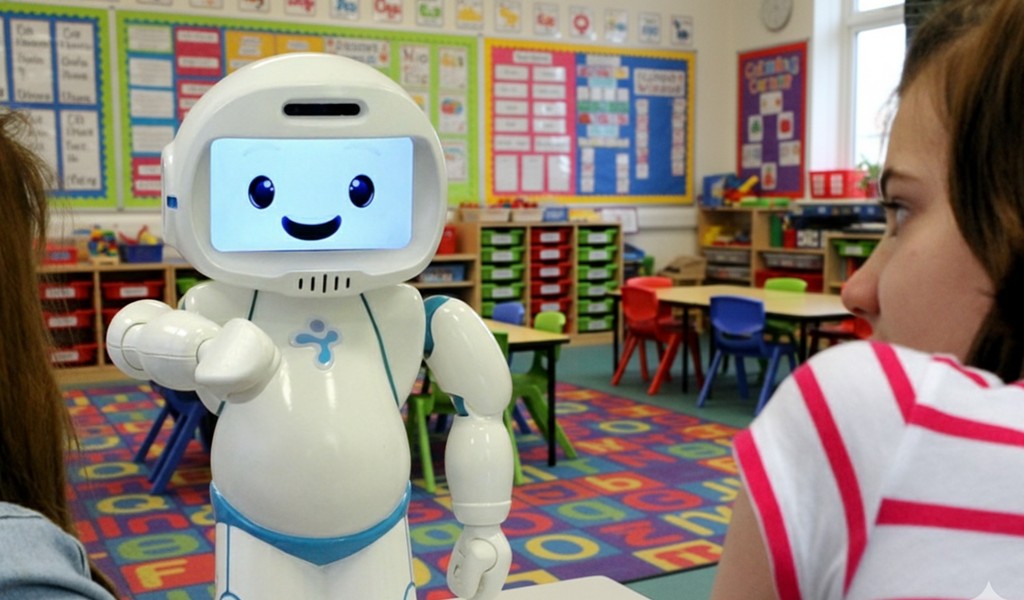Many children with autism spectrum conditions (ASC) struggle with the social aspect of traditional teaching. Therefore, special education schools and institutions are looking for new ways to address teaching. Innovative technology such as robots are increasing in demand for helping learners with autism or other special educational needs. Bridge College was looking for new assistive technology to integrate in their teaching, and so QTrobot has become part of their school. Let us hear Bridge College’s experiences with QTrobot and the impact they already have seen on their students, helping them engage and learn.
Robots help children with learning difficulties, disabilities, and autism
The Covid-19 pandemic has made it difficult for many people to have social interactions. Even though the Bridge College had the possibility to keep up its functions, having the QTrobot has helped students to avoid becoming socially isolated. The aim with using QTrobot at Bridge College is to increase the students’ opportunities to learn and improve the students’ mental wellbeing. The easy-to-understand and simple emotions, as well as the predictable nature of QTrobot are part of the success behind its positive impact on children and young adults with disabilities, autism, or other special educational needs.
Innovative technology for learning in special education classrooms
As a part of Together Trust, one of the leading disability charities of the North West of UK, Bridge college offers personalized support and education for students aged 16-25 years with different levels of learning difficulties, disabilities, complex health needs or autism. A year ago, Jeremy Hoare, Assistive Technologist at Bridge was introduced to QTrobot. Jeremy has seen the power of technology in classrooms, especially for students in special education classrooms and ASC students. Therefore, he was eager to explore the opportunities QTrobot could bring for their students at Bridge College.
Engagement is a key to learning
– the robot breaks down barriers in teaching immediately
Already from the first encounter QTrobot had with a student, the staff at Bridge could see the impact. One student who first met QTrobot, struggles strongly with social situations and eye contact in human interaction with the staff. When this student met QTrobot he immediately started engaging with the robot, tells Jeremy. Also after the session with QT, this student engaged in more eye contact. Jeremy was impressed about how QTrobot could break the barrier that some children may have with engaging and interacting with other people. “It was an initial big sort of bang thing for me that the robot had that immediate effect, and you could see it”, says Jeremy.
How has QTrobot been integrated in the learning at Bridge College? Watch the short video below and continue reading about six ways how Bridge sees that assistive technology such as QTrobot helps in education.
6 Ways Assistive Robot Has Helped Students in Bridge College:
Many children and adults with autism are very interested in technology thanks to its rule-based and predictable nature. It is encouraging and exciting that the robot works as a pivot of social attention, says Jeremy. In practice, this means that the robot is a shared point of interest. The QTrobot acts as a point of joint attention between a child and their educator. The robot is predictable as a technological item, with the expressive nature of a social being. Here are six ways how assistive technology such as a robot gives wide opportunities in education.
1. Students show more engagement and focus and learn more
All students at Bridge College struggle to engage in the classroom, struggle with eye contact, and focus, in a traditional teaching setting. Overwhelmingly, students engage well with the robot, says Jeremy. The robot helps learners to focus, engage, and learn more. Most students look forward to working with the robot and staff at Bridge College has seen an immediate impact on how the students engage.
Overall, students have responded very well, during the one weekly robot session they have had. Students had less need for support and less stimming. Their robot sessions were usually 10-20 minutes, but some sessions even lasted up to 40 minutes. For the students, QT has been a tool to help them concentrate and engage, and through that learn more.
2. Improving ability to communicate
As the students learn to have face-to-face interactions with the robot, it is easier for them to share their social space with other humans. This helps to engage in more communication with the assistants who are operating the robots.
QTrobot has increased engagement between the student and the staff. For example, students have listened more to the instructions, given eye contact to their assistants, and have an increased ability and length of focusing on tasks or series of instructions. Students have also shown more engagement in good mornings. “It is those opportunities of learning that we’re really looking for at Bridge College and the chance to communicate with the students more clearly and develop their ability to do that”, says Jeremy.

3. More like a teacher to become more independent, than a tool
Bridge College staff finds QTrobot as a means to learn social skills better. Reliance on the robot has not been an issue, as sometimes was the case when they used tablets in teaching. The reason is that as a humanoid robot, the students perceive QTrobot more as a teacher, than a tool. At Bridge College they see the student’s wellbeing increase and possibilities to become more independent with using technology.
4. QTrobot helps to transfer learnings to everyday life
Many of the students engaged substantially longer with the robot compared to face-to-face interactions. The students were also very willing to participate in activities. As the students engaged with the robot, the staff also saw how their students started to transfer the learnt skills outside of the robot sessions.
For half of the students, the staff has seen students using the social skills they learnt with the robot in other contexts without the robot. Some support workers who work with the students also outside of the classrooms, say they see the impact in other environments as well. Jeremy points out that they have only had the robot for so short so far, so this is still only a first impression and not to yet draw conclusions from. However, he is impressed by the initial impact.
5. QTrobot creates learning opportunities found nowhere else
The predictability of the robot, the fact that it is repetitive and unchanging removes a lot of the barriers that might exist for the student’s learning. QTrobot offers learning opportunities for the students, which they cannot get the same way elsewhere. Overall, the feedback both from the family members of the students as well as their own staff has been very positive. Bridge College sees strong potential in how QTrobot can help students with different disabilities or special educational needs.
6. QTrobot’s child’s voice is reassuring and supports engagement
Jeremy tells that the fact that QTrobot speaks with a child’s voice, is reassuring for the students. The child’s voice makes the students feel less of need for challenging social interaction, which helps them engage with the robot, says Jeremy. As some students at Bridge are older, up to 25 years, the child’s voice was initially a point of concern. However, the child’s voice turned out to be a key factor of support for the students.
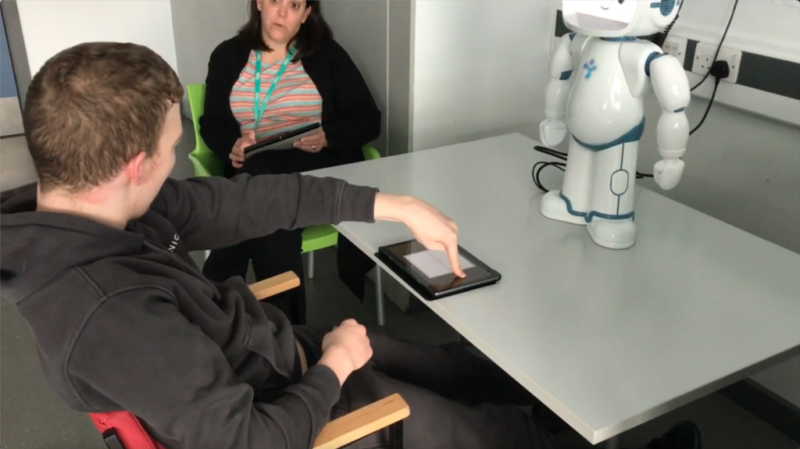
How QTrobot helped Tom to engage and interact
One of the students working with QTrobot at Bridge College is Tom, a 24-year-old student from Stockport. Tom struggles to engage in normal face-to-face interactions. With the study sessions with QTrobot, staff at Bridge college tell that Tom has shown great progress. He has been focused and actively listening, and able to be engaged in the activities over a long time. Nicole Fitton, Support Worker at Bridge College, tells that Tom would struggle to engage in normal face-to-face interactions, but with the robot he has been doing over 20-minute-long sessions, listening and engaging with the QTrobot. This kind of engagement she had never seen happening before.
Tom’s mother Frances appreciates the work and how QTrobot has helped Tom. She sees how the sessions with QTrobot have helped Tom and is hoping that he will be able to transfer his newly learned skills to situations without the robot. Tom also really enjoys working with QTrobot and he is happy that the robot helps him work harder.
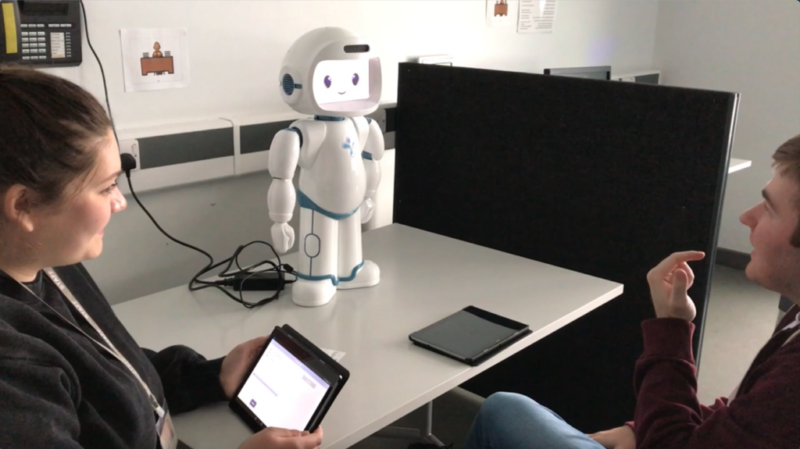
Innovative technology removes barriers in learning
– a success story to continue
Bridge College is currently a year into using QTrobot and already see huge progress of removing barriers in learning for youth with disabilities or special needs. On behalf of the staff, Jeremy says they are looking forward to continuing using QTrobot and seeing the long-term results. Their next steps, as they tell, is to further involve QTrobot in their curriculum and continuous education for all students. Moreover, Jeremy is working to get started with the QTrobot at another school in their area, with younger students. “For me as an assistive technologist it’s a straight up. It removes those barriers that exist for those students”, says Jeremy.
QTrobot Easy of Use and Implementation:
Both the staff and the students at Bridge College have found the QTrobot engaging and easy to use. They say QTrobot is also very easy to set up. ASC Tutor Helen Edwards finds the software really easy, clear and interactive to use. No technical skills are needed, and if we wanted to program own games, we could do it easily. We have needed very minimal prompts to the students from staff, to get the response to what the robot is asking the students to do, says Helen.
Ready-to-use educational material
Teachers and support workers say QTrobot has been so easy to implement, thanks to its ready-made educational material. Bridge College has mostly used the social skills curriculum for their students, where they have seen strong progress in their skill development. Also the early-stage development works very well for the students, as the curricula covers such a wide range of elementary knowledge. Even if the students at Bridge College are older, aged between 16-24, for some students the games of the early-stage development curricula have helped to develop the basic skills needed to become more learn other more complex skills.
QTrobot protects the data of student
Purchasing a technological device, it is natural to ponder over the collection of data. However, Bridge College team could rest reassured, knowing that no personal data is stored on the robot. For each session the robot collects data of the performance of the student, in order to follow their progress. The data is only accessible to the school, and no personal identifiers are collected.
Winner of Award for Innovative Technology in education
In addition to the success within the organisation, the use of innovative technology has been recognised also on a wider scale. Bridge College with their integration of the QTrobot is one of the winners of the Natspec Awards 2021. The Natspec award was given as a recognition of the implementation of QTrobot, who helped to enhance social interactions, communication skills, levels of engagements and the mental wellbeing of the students.
The Natspec Awards promote innovation, ensure continuous improvement, and raise standards across the specialist further education sector. The awards are handed out to organisations and institutions as a recognition and celebration of excellent practice. Awards are handed out in different categories, amongst others innovative use of technology, wellbeing and mental health, and home learning.
How can I get a QTrobot for School or Home?
If like Bridge College, you are interested in introducing the educational social robot as an additional method to teaching, we’re happy to help. Did you know that there are two versions of QTrobot for autism and special needs education?
QTrobot for Schools is developed for teachers, support workers or therapists to integrate in the classroom in educational centres. On the other hand, parents of children with autism or other special educational needs can purchase QTrobot for Home to help to develop new skills on a regular basis, as a supplement to traditional teaching. Both QTrobots come with integrated educational curricula, to get started with teaching immediately.
Would you like to integrate QTrobot in the teaching in your classroom or at home?
Book a free consultation and live demo with our specialist team here!
